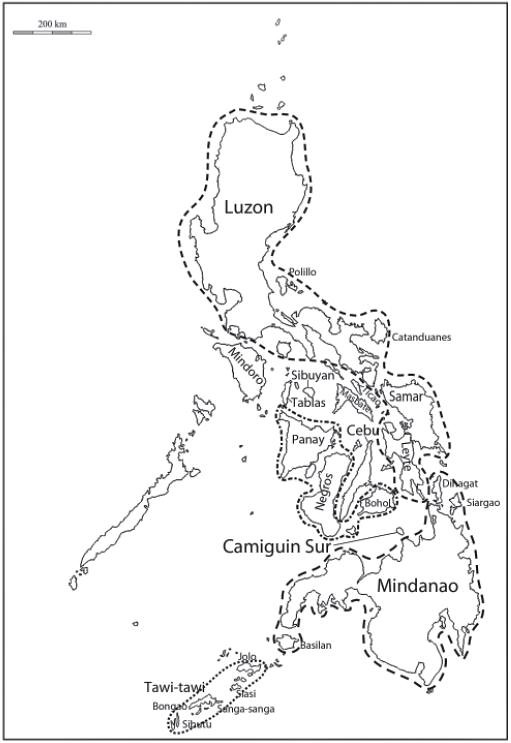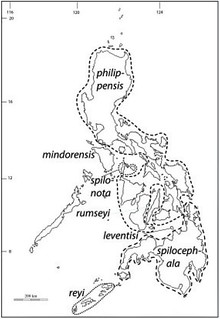Journal club: Two new owl species may provide insight into how early birds colonised the Philippines
SUMMARY: Two new owl species were discovered in the Philippine Islands and five more Philippine owls were given full species status
![]() The Philippine Archipelago is filled with a tremendous variety of living things, and hundreds of new species have been discovered recently on the islands. The most recent addition to this roll call of biodiversity are not one, but two species of owls that are new to science.
The Philippine Archipelago is filled with a tremendous variety of living things, and hundreds of new species have been discovered recently on the islands. The most recent addition to this roll call of biodiversity are not one, but two species of owls that are new to science.
The discoveries were confirmed by Pam Rasmussen, assistant professor of zoology and assistant museum curator of mammalogy and ornithology at Michigan State University in East Lansing. Publishing the discovery of two new bird species in one scientific paper is so rare that Professor Rasmussen and other researchers couldn’t recall the last time it happened, according to the MSU press release.
Professor Rasmussen, who is first author on the paper, led the international team, which included individuals from BirdLife International, the Oriental Bird Club, the Philippines Biodiversity Conservation Foundation and Birdtour Asia.
These owls are found on the Philippine islands of Camiguin Sur and Cebu, for which they are being named (figure 1):
 Figure 1. Map of the known distribution of taxa of the Philippine hawk owl, Ninox philippensis (sensu lato).
Figure 1. Map of the known distribution of taxa of the Philippine hawk owl, Ninox philippensis (sensu lato).
.. .. .. .. .. .. .. .. .. .. ..
“More than 15 years ago, we realized that new subspecies of Ninox hawk-owls existed in the Philippines,” said Professor Rasmussen in a press release.
“When we first heard the songs of both owls, we were amazed because they were so distinctly different that we realized they were new species”, Professor Rasmussen added.
But the native wildlife on these islands is not well known, so it took many years of follow-up work in the field as well as in the lab and in museum collections to fully realise what they had stumbled across.
“But it wasn’t until last year that we obtained enough recordings that we could confirm that they were not just subspecies, but two new species of owls.”
Unlike many songbirds and parrots, which can learn other species’ songs and sounds, owls only produce their own species-specific sounds.
“The owls don’t learn their songs, which are genetically programmed in their DNA and are used to attract mates or defend their territory,” explained Professor Rasmussen in a press release. “So if they’re very different, they must be new species.”
The team analysed the newly-recorded songs and found that the owls on Mindoro (mindorensis), Mindanao (spilocephala), the Sulu Islands (reyi) and Camiguin Sur (one of the two newly-discovered species) have especially noticeable vocal differences that distinguish them from all other taxa.
Not only do these owls have very different calls and voices, but careful examinations of museum specimens and photographs of wild birds reveal small but consistent differences in plumage colour and pattern and, in some cases, measurable differences in body shape and size (figure 2):
 Figure 2: Two owl species discovered that are new to science in the Philippines. Left: Cebu hawk owl, Ninox rumseyi (new species), Cebu island, 3 January 2012.
Figure 2: Two owl species discovered that are new to science in the Philippines. Left: Cebu hawk owl, Ninox rumseyi (new species), Cebu island, 3 January 2012.
Image: Christian Artuso.
Right: Camiguin hawk owl, N. leventisi (new species), Camiguin Sur, 8 June 2011.
Image: R. O. Hutchinson.
.. .. .. .. .. .. .. .. .. .. ..
One of the new species is the Cebu hawk owl, Ninox rumseyi (figure 2, left), of which only one individual has been seen so far [listen: single bird, audio with sonogram and notes]. According to the paper, bonded pairs of this species sing duets [listen: duetting pair, audio with sonogram and notes].
The other new species, the Camiguin hawk owl, N. leventisi (figure 2, right), has a distinct growling tone instead of the high-pitched melodious song that is typical for these owls [listen: single bird, audio with sonogram and notes]. During field observations, the team found that pairs of this species often sing duets whilst facing each other.
As part of this study, the paper’s authors carefully re-examined other Philippine owls held in museum collections around the world. Interestingly, although some of the specimens have been in these collections for many years, two of these species and one subspecies have heretofore remained undescribed until now.
 Pam Rasmussen, Michigan State University assistant professor of zoology and assistant curator of mammalogy and ornithology with some of the bird collections held by the MSU Museum.
Pam Rasmussen, Michigan State University assistant professor of zoology and assistant curator of mammalogy and ornithology with some of the bird collections held by the MSU Museum.
Image courtesy of MSU.
.. .. .. .. .. .. .. .. .. .. ..
The team’s analysis indicates that five more owl taxa that were considered to be subspecies of the Philippine hawk owl, N. philippensis, are themselves full species. These owls: the Luzon hawk owl, N. philippensis; the Mindanao hawk owl, N. spilocephala; the Mindoro hawk owl, N. mindorensis; the Sulu hawk owl, N. reyi and the Romblon hawk owl, N. spilonota.
The team found that these owls cluster into one of three distinct types, primarily defined by shared similarities in plumage colour and pattern: one type has streaked underparts and a plain crown (the owls of Luzon and many other islands); another type has a mottled or barred breast, streaked lower underparts, and a spotted crown (the owl on Mindanao); and a third type has some barring that fades into almost plain underparts, known as the “unstreaked” group. Because they look so similar, species in each of these plumage-type groups may be each other’s closest relatives.
 Yet, when the team compared the geographic distribution of these three owl types, they found something strange. The larger of these owls, those with unstreaked plumages, are sprinkled across a number of well-separated islands whilst the smaller, streakier owls occupy the largest islands (see map, right). Since close relatives tend to be located near each other, this is perplexing. How did this happen? This unusual spatial distribution pattern provides a tantalizing hint at an unexpected pattern of how owls originally colonised the Philippine Archipelago. But until the birds’ precise evolutionary relationships are clarified by molecular analysis, the authors can only guess at which historic and geologic events led to this strange distribution pattern.
Yet, when the team compared the geographic distribution of these three owl types, they found something strange. The larger of these owls, those with unstreaked plumages, are sprinkled across a number of well-separated islands whilst the smaller, streakier owls occupy the largest islands (see map, right). Since close relatives tend to be located near each other, this is perplexing. How did this happen? This unusual spatial distribution pattern provides a tantalizing hint at an unexpected pattern of how owls originally colonised the Philippine Archipelago. But until the birds’ precise evolutionary relationships are clarified by molecular analysis, the authors can only guess at which historic and geologic events led to this strange distribution pattern.
But there are other, more pressing, concerns to be addressed as well. Although the Cebu and Camiguin hawk owls are new to science, they and three others that are newly given full species status already are in danger of extinction due to clearing of their forested habitat.
“On Cebu, where it was rediscovered in 1998 after a gap of 110 years, the total population of Cebu hawk owls may be just 192 pairs (and possibly many fewer) scattered among 11 forest patches”, the authors note in their paper. “On Camiguin Sur, forest covers just the centre of the small island, and numbers of the species cannot be high.”
Sources:
P. C. Rasmussen, D. N. S. Allen, N. J. Collar, B. De Meulemeester, R. O. Hutchinson, P. G. C. Jakosalem, R. S. Kennedy, F. R. Lambert, & L. M. Paguntalan (2012). Vocal divergence and new species in the Philippine Hawk Owl Ninox philippensis complex. Forktail, 28, 1-20. [free PDF]
Michigan State University press release
Here’s a video featuring Professor Rasmussen in the field, including brief portions of the two owl species’ voices (note: the audio quality is poor, so you’ll have to turn up the sound on your computer and listen carefully):
NOTE: This story is reformatted from the original that was published on The Guardian.
.. .. .. .. .. .. .. .. .. .. ..
twitter: @GrrlScientist
facebook: grrlscientist
evil google+: grrlscientist
email: grrlscientist@gmail.com

Awesome reading! TFS!
thank you!